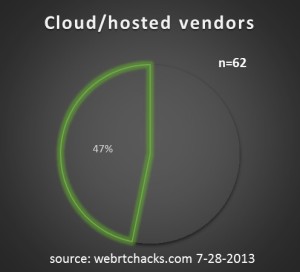This post provides background and methodology to the WebRTC Tool Vendor Directory.

I wanted to get a better understanding of the state of the WebRTC market. For a technology like WebRTC to be successful it has to be utilized by developers and developers use tools, so I set out to review all the WebRTC tool companies. I thought I had a good handle on the WebRTC market. I’ve done this kind of process many times before so I thought it would be easy. The WebRTC market is new, so I through it would be quick to review a couple dozen vendors.
This turned out to be a bigger project than planned.
Methodology
I started by building a list through a combination or tradeshow exhibitor lists, #webrtc on twitter, and general web search. Then I started looking up each company the list, one by one – taking more time on the developer focused ones. Specifically I was looking for a developer page and mention of an API or SDK. Enterprise-oriented video services and plug-and-play type infrastructure is excluded from the directory for now.
There are a lot of vendors. Tsahi Levant-Levi has referenced a list of 190 companies with some involvement in WebRTC. I thought most of these would be sites using WebRTC; not developer focused companies. I was off – of my master list of about 120 companies, half have some kind of developer focus.
I chunked through a bunch, took notes, looked for patterns, went back to previous companies for more investigation and repeated the process until I honed the segmentation into quantitatively substantial but qualitatively meaningful buckets:
Target audience |
What are the primary development communities the tool vendor targets? |
|
Web-site admins of small sites, often using standard platforms like WordPress and Drupal |
|
IT and enterprise developers at larger scale businesses and contact centers that provide web-based services – including retail websites, support portals, etc. – a means to an end to support their primary business. |
|
Web and app developers at companies where providing web-powered services to consumers or businesses is the primary business. |
|
Service and network developers at the roughly 2000 traditional and competitive telecom service providers who power the PSTN and the associated communities – like the telephony people inside enterprises – that interconnect with them. |
Developer Skills |
What kind of development expertise do the tool vendors require? |
|
Provide custom development services on contractual basis |
|
Simple to install Plug-ins and widgets for website admins with minimal development expertise |
|
SDKs and API services for web developers who specialize in user-facing aspects of coding like layout and user interface – i.e. JavaScript SDK’s, REST API’s |
|
Modules, SDK’s, and frameworks for server-side developers who specialize in enabling the underlying the service and network infrastructure – i.e. tools for .NET, node.js, Python, C++, etc. |
|
Software and hardware for developers with expertise on telecom protocols, networks, and services – SIP, 3GPP IMS, etc. |
|
Native applications developers (non-web but often leveraging web-oriented development) – iOS, Android, Windows Phone, BB10, etc. |
Payment terms |
the payment models offered for the primary WebRTC tool product (not associated support services) |
|
Licensed software (and sometimes hardware) at a price; often includes option for dedicated product/service support |
|
Volume based licensing that provides where low-volumes are offered at no charge |
|
Products are available free of charge on an open source licensing model. Commercial support options may be available directly or via affiliates |
Infrastructure |
Considerations for the physical devices and network connections |
|
The vendor provides servers and network as-a-service – i.e. in the cloud; typically on a subscription basis |
|
Provides interworking with legacy telephony infrastructure such as the PSTN, SIP trunks, and enterprise UC |
In the spirit of The Lean Start-up, I am posting this directory with a minimal set of information to start out – just the fields above, the company name with link, and a brief “marketing” description directly taken or adapted from the company’s web materials. I have more details I will publish in time.
High-level findings
Below are some high-level findings that I find noteworthy. For a more narrative guide on the elements above and how to find the best WebRTC development tools to fit your needs please see my WebRTC tools – Where to Begin post.
Telecom is making its mark
Given that WebRTC was initially a push from Google and then Mozilla, I was surprised to see telecom-oriented companies comprise roughly half the list. Indeed, most traditional telecom equipment manufacturers have made some kind of announcement around WebRTC. I know of several more that will need to be added soon and should perhaps be included already. I think there are a few reasons for this:
- Traditional telecom providers see both an opportunity and threat in WebRTC – they are poised to figure it out before while they have a chance
- WebRTC is based on most of the same underlying VoIP technologies much of the industry has been working with for years – moving VoIP to a web model is a logical adjacency
- Service providers and large enterprise UC teams are used to buying a lot of stuff – there is an established multi-billion dollar a year market for telephony infrastructure for this audience. WebRTC infrastructure for web-oriented providers is a much trickier market – early-stage startups don’t spend a lot of money and established companies often just built everything themselves.
WebRTC in the cloud
In an effort to minimize barriers and prove services works, it looks like nearly every company that can is providing some kind of cloud or hosted service. 21 out of 30 of the web-service oriented companies are doing this. The others in the group are largely open source companies; some of which like Asterisk and Kamilio have customers who offer a hosted option. In a sign of changing times, more than a handful of the telco-oriented vendors also offer a hosted solution.
Legacy connectivity features common
Extension of VoIP-based services and applications over the web is only one of many use cases for WebRTC, and certainly not the most innovative. I was surprised to see so many companies supporting options to connect to the PSTN and/or SIP-based enterprise communications infrastructure – half of the list! Unsurprisingly, the strong telco and enterprise-oriented contingents comprise most of this group.
This data is far from perfect but it will get better
It is impossible to develop segmentation that appeases every vendor, particularly in a rapidly emerging market like this one. That being said, my audience here is developers looking to build WebRTC applications – it’s their opinions that really matter at the end of the day. Please keep me honest.
I am sure I have a lot of things misclassified. I constantly come across companies and products I missed and will be updating this regularly. I am happy to make corrections and fix omissions– please leave a comment on this post or contact me privately.
If this provides to be popular I have many ideas on how this directory could evolve including:
- Adding more details
- Product-level specificity
- More details on infrastructure & network options – i.e. media mixing, TURN sever use, Flash Gateway, etc.
- More granular SDK info – Android, iOS, Windows, etc.
- Known customers
- More exhaustive review of open source projects
- Inclusion of non-developer oriented IT infrastructure that was excluded
- Creating a standard product information form for vendors
- Developer surveys to complement the data
{“author”, “chad“}










Leave a Reply